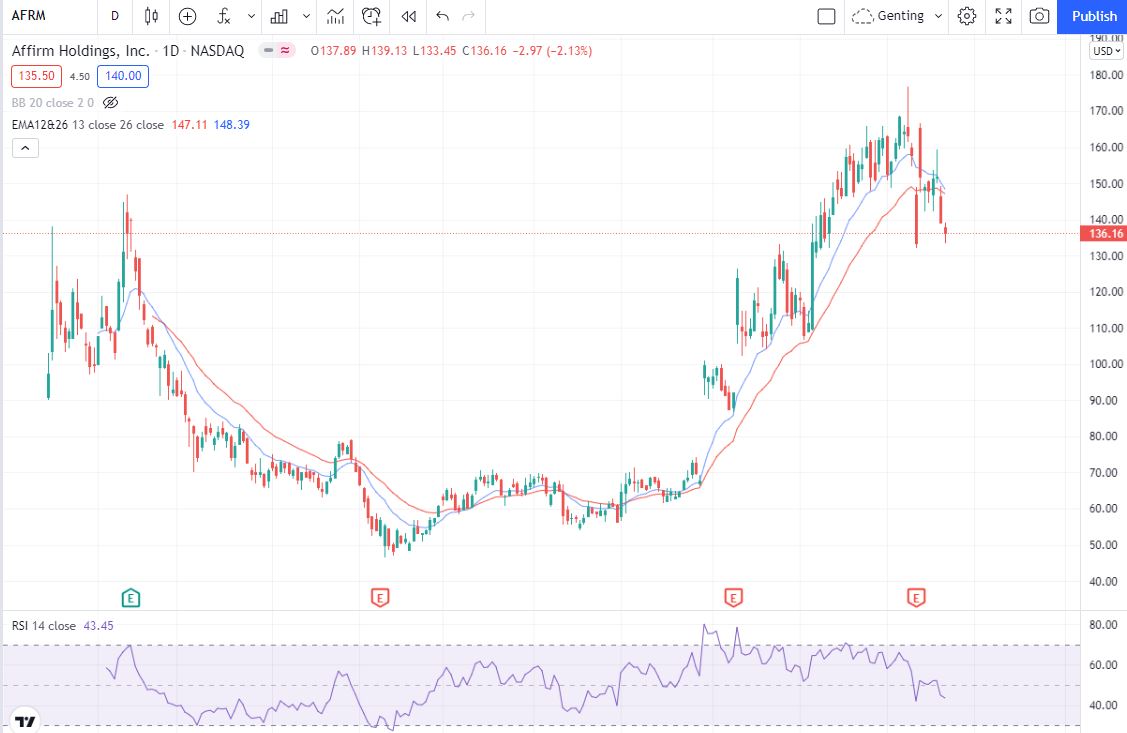Is AFRM A Buy Now? What Affirm's Fundamentals.
DAVID SAITO-CHUNG
08:00 PM ET 11/19/2021
When it comes to investing in new fintech companies and the financing concept of BNPL — buy now, pay later — Affirm stock comes immediately to mind. And what a sensational week of action it's having.
Affirm (AFRM) likely scared the wits of shareholders on Nov. 10.
The stock nose-dived 15% in the heaviest volume in more than three weeks. And 22.5 million shares exchanged hands that day, 42% above its average turnover over the past 50 sessions. Affirm stock also came close to undercutting a critical technical level on its chart, the 50-day moving average.
But after reporting third-quarter results late that day, AFRM went into bungee cord-jumping mode. Shares rose as much as 24% intraday on Thursday, Nov. 11, then settled at 151.83. Good for a 13.7% gain. Volume soared again, rising more than double its usual level.
Shares have cooled off again. Yet the fintech company, started by Max Levchin, entrepreneur and member of the so-called "PayPal mafia" of Silicon Valley fame, still sports a gain in excess of 175% from its initial public offering at $49 a share in January.
Shares fell hard this past week on news that it is planning a convertible debt offering.
On Friday, Affirm priced its $1.5 billion offering of convertible debt with a 0% coupon, maturing in November 2026. The zero coupon means the holder will not receive regular interest. The offering got up-sized from an initial plan to sell $1.25 billion. Affirm says it may not redeem the notes prior to Nov. 20, 2024.
Affirm Stock Today:
IBD Stock Checkup shows Affirm with a Composite Rating of 57 on a scale of 1 to 99, as of Monday.
That compares unfavorably with Affirm's industry peers in consumer credit and banking giants, including American Express (AXP) (a decent, but not great, 82 Composite score), Goldman Sachs (GS) (87 Composite) and Mastercard (MA) (68). Affirm's Composite, however, beats a 45 rating for PayPal (PYPL), a struggling member of IBD Long-Term Leaders and former member of IBD Big Cap 20.
Ideally, focus on companies with a 90 Composite or higher. However, newer issues often have no earnings history or a very slim record of profitability. For Affirm, the San Francisco-based company lost $1.75 a share in fiscal 2021, ended in June. The Street sees more net losses in FY 2022 (-$1.01) and FY 2023 (-$0.83). Affirm has 269.4 million shares outstanding.
On the positive side, however, Affirm is growing the top line at lightning pace; revenues have grown 86%, 89%, 120%, 98%, 57%, 67%, 71% and 55% vs. year-ago levels in the past eight quarters.
"Legacy payment options, archaic systems, and traditional risk and credit underwriting models can be harmful, deceptive, and restrictive to both consumers and merchants," the company wrote in its 424b IPO prospectus, filed with the Securities & Exchange Commission." We believe that they are not well-suited for increasingly digital and mobile-first commerce, and are built on legacy infrastructure that does not support the innovation required for modern commerce to evolve and flourish. Our platform is designed to address these problems."
The company charges zero late fees. As of June 30, Affirm counts at least 10 million customers.
Plus, Affirm's Composite Rating masks an excellent Relative Strength Rating of 98 on a scale of 1 to 99.
Mutual fund ownership keeps rising fast. The total has jumped to 339 funds at the end of Q3 this year vs. 255 in June. Bullish. You want to see increasing institutional sponsorship. That's one hallmark of the I in CAN SLIM.
When investing in a growth stock, make sure it has solid company. Does it belong to a leading sector in the stock market itself?
Overall, that's pretty much the case for Affirm. While its credit card payment and processing industry group ranks near the middle among 197 IBD industry groups for six-month price performance, the finance sector holds the 7th rung among 33 sectors in the IBD stock research tables.
Affirm Stock: Proper Buy Points
Affirm's stock price corrected in a huge way after its breakout attempt past a 138.08 correct buy point in a narrow IPO base imploded. As you can see on the daily chart, in early February the large cap failed to get much traction after clearing the base's left-side high of 137.98.
Then it tanked just days later. This negative price action triggered the golden rule of investing: cut your losses short. By saving precious capital, you insure the portfolio from a devastating loss. And you ensure the opportunity to invest in a better stock or the same stock in stronger market conditions.
For Affirm stock, the new opportunity came months later.
After falling as much as 68% from its 146.90 peak, AFRM bottomed out at 46.50 in May, then began to rise slowly. It took months for the stock to begin building the right side of a promising new chart pattern. But it eventually crossed above the 50-day moving average and stayed above it.
On Aug. 30, shares gapped up in bullish fashion. A 46% gain in the heaviest volume in the stock's history catapulted Affirm to a five-month high, thanks to a business tie-up with an e-commerce titan. The next several days saw the stock tilt lower in mild fashion. Volume was still heavy, but declined from the mega-active day of Aug. 30.
AFRM Stock: A Follow-On Entry
On Sept. 10, Affirm stock broke out past the handle buy point of 101.10 on second-quarter results. Volume surged again. This move stoked AFRM's first breakout and legitimate buy opportunity.
Two separate pullbacks in September and early October created additional handle entries. Why? AFRM was still trading beneath the deep cup pattern's left-side peak of 146.90.
Thus, new entry points at 126.56 (10 cents above the Sept. 10 peak) and 133.27 (a dime above the Sept. 24 high) gave traders another chance to buy on strength. Always buy within the 5% buy zone after a breakout.
Indeed, Affirm pulled back sharply after rising past the 126.56 entry point. At one point, the stock fell as much as 15.7% below this buy point. This would normally trigger the golden rule of investing: cut your losses short. However, from the context of the daily chart, notice how AFRM got support near the 21-day exponential moving average. You'd expect this after a strong breakout — in Affirm's case, since it soared past 101.10.
Since then, the Affirm stock price has moved the way you'd expect: up.
This new pullback to the 50-day moving average, or to the 10-week line on a weekly chart, offers a follow-on buy point after a successful breakout.
In this situation, you want to buy as close as possible to the actual 50-day or 10-week itself.
The 10-week moving average has risen to around 140 as of Thursday's close. Buying within 5% to 10% of this price level is acceptable — but only if confirmed uptrend. You want the market acting as a tailwind, not a headwind.
AFRM ended the week with an 8% drop in below-average turnover. The stock closed below its 10-week line, which is now near 141.
So at this point, Affirm stock is not a buy. Ideally, you want to wait until the stock begins to rally again and clear the 10-week moving average with gusto before deploying your hard-earned capital. In other words, buy on strength, not on the way down.
免责声明:上述内容仅代表发帖人个人观点,不构成本平台的任何投资建议。




Great ariticle, would you like to share it?